Understanding the Stolen Generations
VerifiedAdded on 2020/04/13
|10
|2434
|43
AI Summary
This assignment delves into the historical context of the Stolen Generations in Australia, examining the government policies that led to the forced removal of Aboriginal and Torres Strait Islander children from their families. It analyzes the devastating consequences of this policy, including the disruption of cultural transmission, intergenerational trauma, and the loss of language and identity. The assignment also highlights the ongoing efforts towards reconciliation and healing within Indigenous communities.
Contribute Materials
Your contribution can guide someone’s learning journey. Share your
documents today.
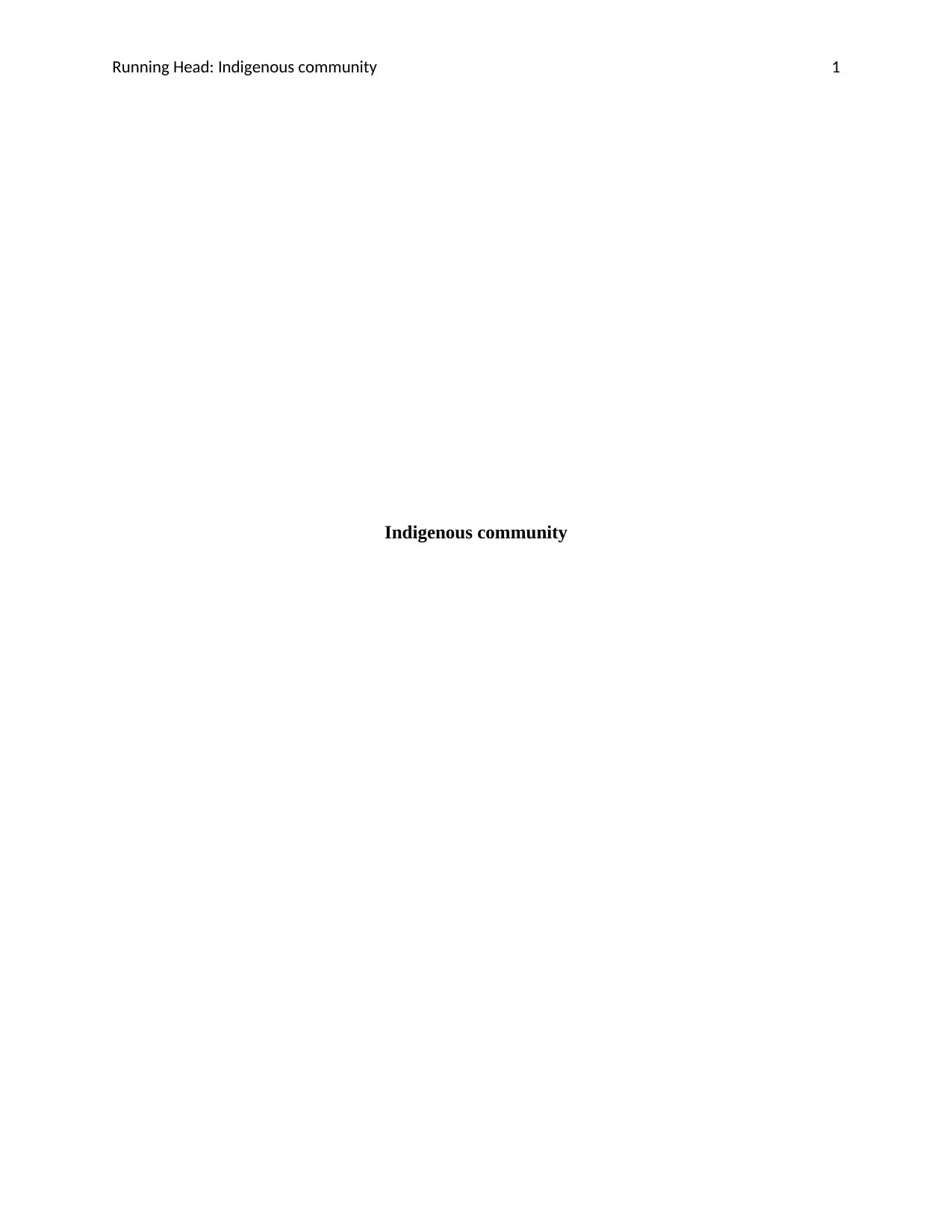
Running Head: Indigenous community 1
Indigenous community
Indigenous community
Secure Best Marks with AI Grader
Need help grading? Try our AI Grader for instant feedback on your assignments.
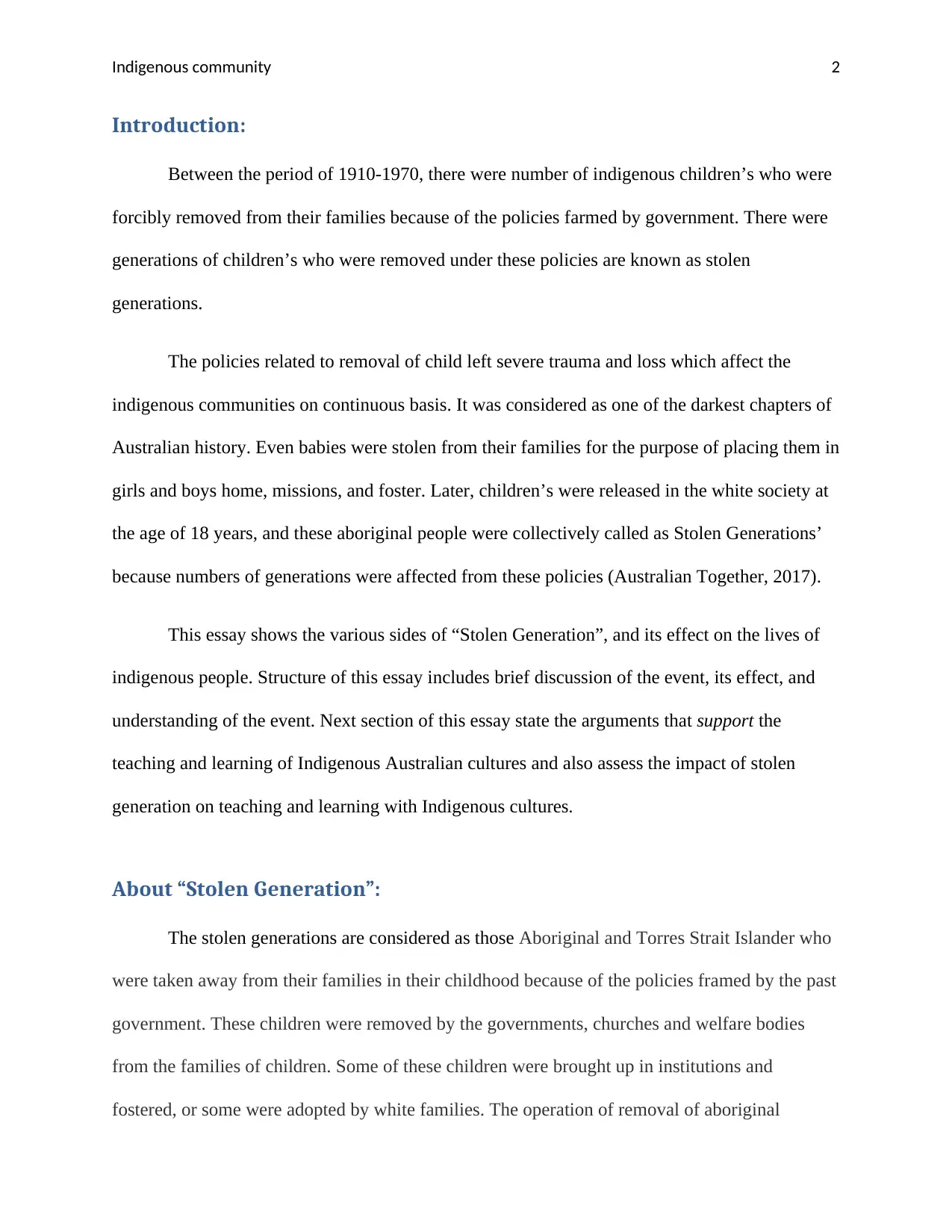
Indigenous community 2
Introduction:
Between the period of 1910-1970, there were number of indigenous children’s who were
forcibly removed from their families because of the policies farmed by government. There were
generations of children’s who were removed under these policies are known as stolen
generations.
The policies related to removal of child left severe trauma and loss which affect the
indigenous communities on continuous basis. It was considered as one of the darkest chapters of
Australian history. Even babies were stolen from their families for the purpose of placing them in
girls and boys home, missions, and foster. Later, children’s were released in the white society at
the age of 18 years, and these aboriginal people were collectively called as Stolen Generations’
because numbers of generations were affected from these policies (Australian Together, 2017).
This essay shows the various sides of “Stolen Generation”, and its effect on the lives of
indigenous people. Structure of this essay includes brief discussion of the event, its effect, and
understanding of the event. Next section of this essay state the arguments that support the
teaching and learning of Indigenous Australian cultures and also assess the impact of stolen
generation on teaching and learning with Indigenous cultures.
About “Stolen Generation”:
The stolen generations are considered as those Aboriginal and Torres Strait Islander who
were taken away from their families in their childhood because of the policies framed by the past
government. These children were removed by the governments, churches and welfare bodies
from the families of children. Some of these children were brought up in institutions and
fostered, or some were adopted by white families. The operation of removal of aboriginal
Introduction:
Between the period of 1910-1970, there were number of indigenous children’s who were
forcibly removed from their families because of the policies farmed by government. There were
generations of children’s who were removed under these policies are known as stolen
generations.
The policies related to removal of child left severe trauma and loss which affect the
indigenous communities on continuous basis. It was considered as one of the darkest chapters of
Australian history. Even babies were stolen from their families for the purpose of placing them in
girls and boys home, missions, and foster. Later, children’s were released in the white society at
the age of 18 years, and these aboriginal people were collectively called as Stolen Generations’
because numbers of generations were affected from these policies (Australian Together, 2017).
This essay shows the various sides of “Stolen Generation”, and its effect on the lives of
indigenous people. Structure of this essay includes brief discussion of the event, its effect, and
understanding of the event. Next section of this essay state the arguments that support the
teaching and learning of Indigenous Australian cultures and also assess the impact of stolen
generation on teaching and learning with Indigenous cultures.
About “Stolen Generation”:
The stolen generations are considered as those Aboriginal and Torres Strait Islander who
were taken away from their families in their childhood because of the policies framed by the past
government. These children were removed by the governments, churches and welfare bodies
from the families of children. Some of these children were brought up in institutions and
fostered, or some were adopted by white families. The operation of removal of aboriginal
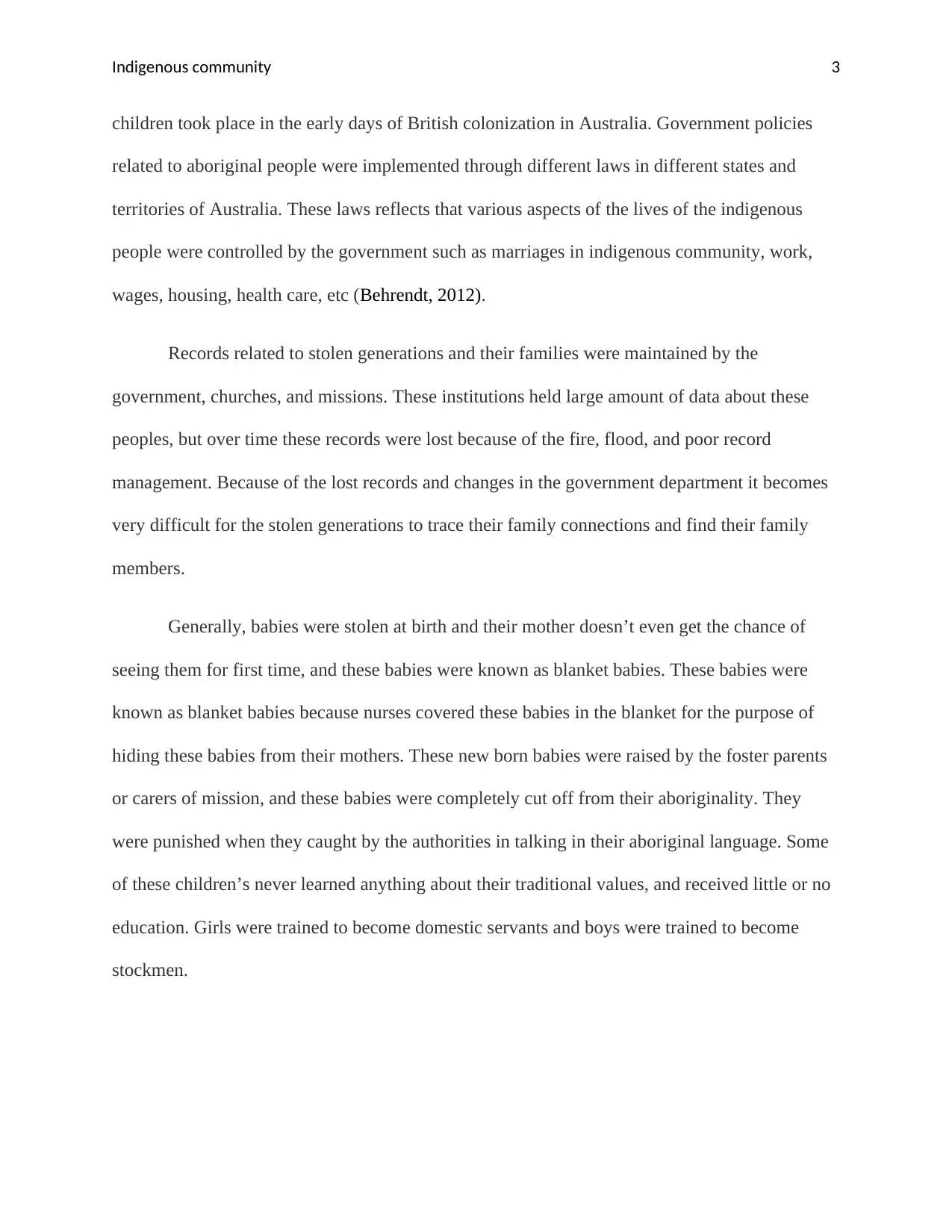
Indigenous community 3
children took place in the early days of British colonization in Australia. Government policies
related to aboriginal people were implemented through different laws in different states and
territories of Australia. These laws reflects that various aspects of the lives of the indigenous
people were controlled by the government such as marriages in indigenous community, work,
wages, housing, health care, etc (Behrendt, 2012).
Records related to stolen generations and their families were maintained by the
government, churches, and missions. These institutions held large amount of data about these
peoples, but over time these records were lost because of the fire, flood, and poor record
management. Because of the lost records and changes in the government department it becomes
very difficult for the stolen generations to trace their family connections and find their family
members.
Generally, babies were stolen at birth and their mother doesn’t even get the chance of
seeing them for first time, and these babies were known as blanket babies. These babies were
known as blanket babies because nurses covered these babies in the blanket for the purpose of
hiding these babies from their mothers. These new born babies were raised by the foster parents
or carers of mission, and these babies were completely cut off from their aboriginality. They
were punished when they caught by the authorities in talking in their aboriginal language. Some
of these children’s never learned anything about their traditional values, and received little or no
education. Girls were trained to become domestic servants and boys were trained to become
stockmen.
children took place in the early days of British colonization in Australia. Government policies
related to aboriginal people were implemented through different laws in different states and
territories of Australia. These laws reflects that various aspects of the lives of the indigenous
people were controlled by the government such as marriages in indigenous community, work,
wages, housing, health care, etc (Behrendt, 2012).
Records related to stolen generations and their families were maintained by the
government, churches, and missions. These institutions held large amount of data about these
peoples, but over time these records were lost because of the fire, flood, and poor record
management. Because of the lost records and changes in the government department it becomes
very difficult for the stolen generations to trace their family connections and find their family
members.
Generally, babies were stolen at birth and their mother doesn’t even get the chance of
seeing them for first time, and these babies were known as blanket babies. These babies were
known as blanket babies because nurses covered these babies in the blanket for the purpose of
hiding these babies from their mothers. These new born babies were raised by the foster parents
or carers of mission, and these babies were completely cut off from their aboriginality. They
were punished when they caught by the authorities in talking in their aboriginal language. Some
of these children’s never learned anything about their traditional values, and received little or no
education. Girls were trained to become domestic servants and boys were trained to become
stockmen.
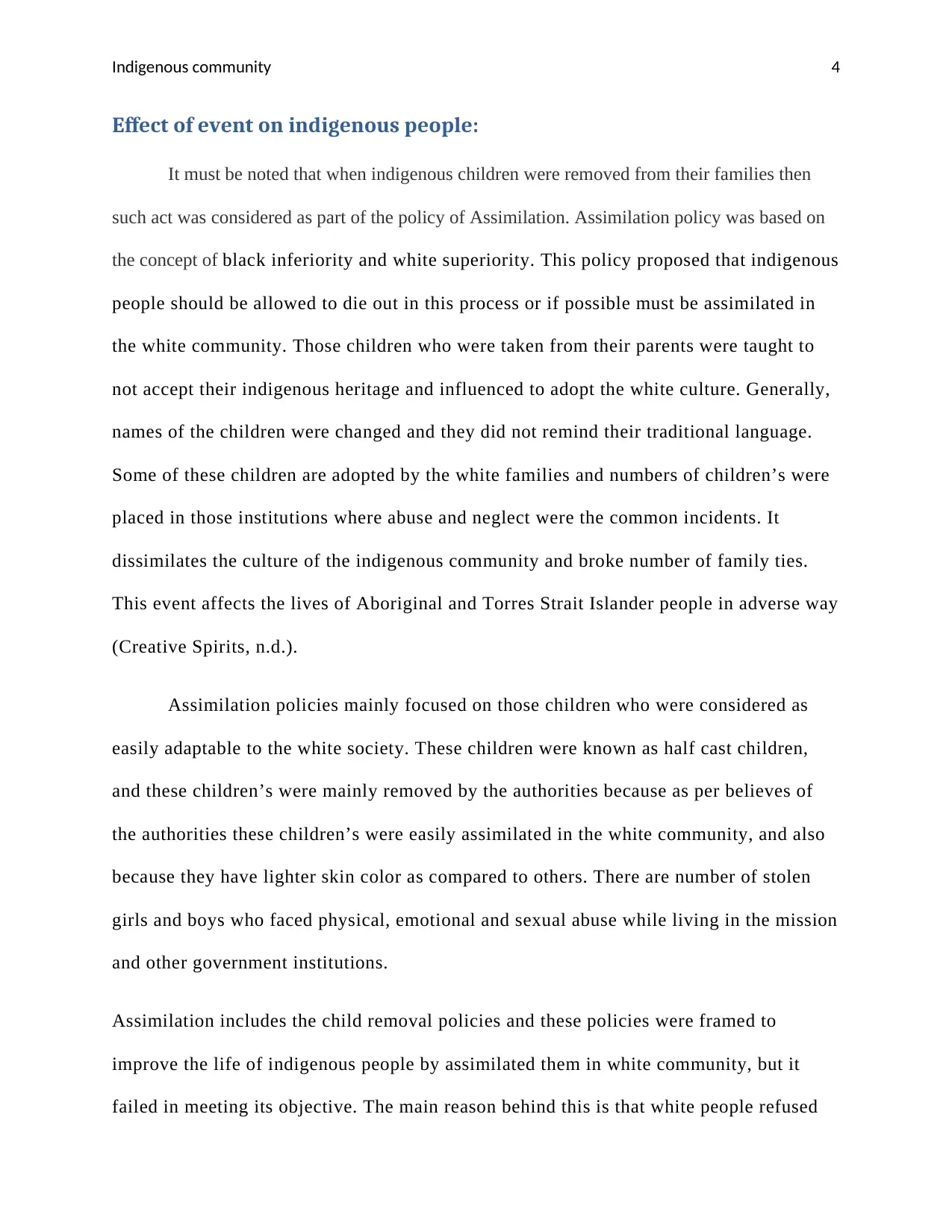
Indigenous community 4
Effect of event on indigenous people:
It must be noted that when indigenous children were removed from their families then
such act was considered as part of the policy of Assimilation. Assimilation policy was based on
the concept of black inferiority and white superiority. This policy proposed that indigenous
people should be allowed to die out in this process or if possible must be assimilated in
the white community. Those children who were taken from their parents were taught to
not accept their indigenous heritage and influenced to adopt the white culture. Generally,
names of the children were changed and they did not remind their traditional language.
Some of these children are adopted by the white families and numbers of children’s were
placed in those institutions where abuse and neglect were the common incidents. It
dissimilates the culture of the indigenous community and broke number of family ties.
This event affects the lives of Aboriginal and Torres Strait Islander people in adverse way
(Creative Spirits, n.d.).
Assimilation policies mainly focused on those children who were considered as
easily adaptable to the white society. These children were known as half cast children,
and these children’s were mainly removed by the authorities because as per believes of
the authorities these children’s were easily assimilated in the white community, and also
because they have lighter skin color as compared to others. There are number of stolen
girls and boys who faced physical, emotional and sexual abuse while living in the mission
and other government institutions.
Assimilation includes the child removal policies and these policies were framed to
improve the life of indigenous people by assimilated them in white community, but it
failed in meeting its objective. The main reason behind this is that white people refused
Effect of event on indigenous people:
It must be noted that when indigenous children were removed from their families then
such act was considered as part of the policy of Assimilation. Assimilation policy was based on
the concept of black inferiority and white superiority. This policy proposed that indigenous
people should be allowed to die out in this process or if possible must be assimilated in
the white community. Those children who were taken from their parents were taught to
not accept their indigenous heritage and influenced to adopt the white culture. Generally,
names of the children were changed and they did not remind their traditional language.
Some of these children are adopted by the white families and numbers of children’s were
placed in those institutions where abuse and neglect were the common incidents. It
dissimilates the culture of the indigenous community and broke number of family ties.
This event affects the lives of Aboriginal and Torres Strait Islander people in adverse way
(Creative Spirits, n.d.).
Assimilation policies mainly focused on those children who were considered as
easily adaptable to the white society. These children were known as half cast children,
and these children’s were mainly removed by the authorities because as per believes of
the authorities these children’s were easily assimilated in the white community, and also
because they have lighter skin color as compared to others. There are number of stolen
girls and boys who faced physical, emotional and sexual abuse while living in the mission
and other government institutions.
Assimilation includes the child removal policies and these policies were framed to
improve the life of indigenous people by assimilated them in white community, but it
failed in meeting its objective. The main reason behind this is that white people refused
Secure Best Marks with AI Grader
Need help grading? Try our AI Grader for instant feedback on your assignments.
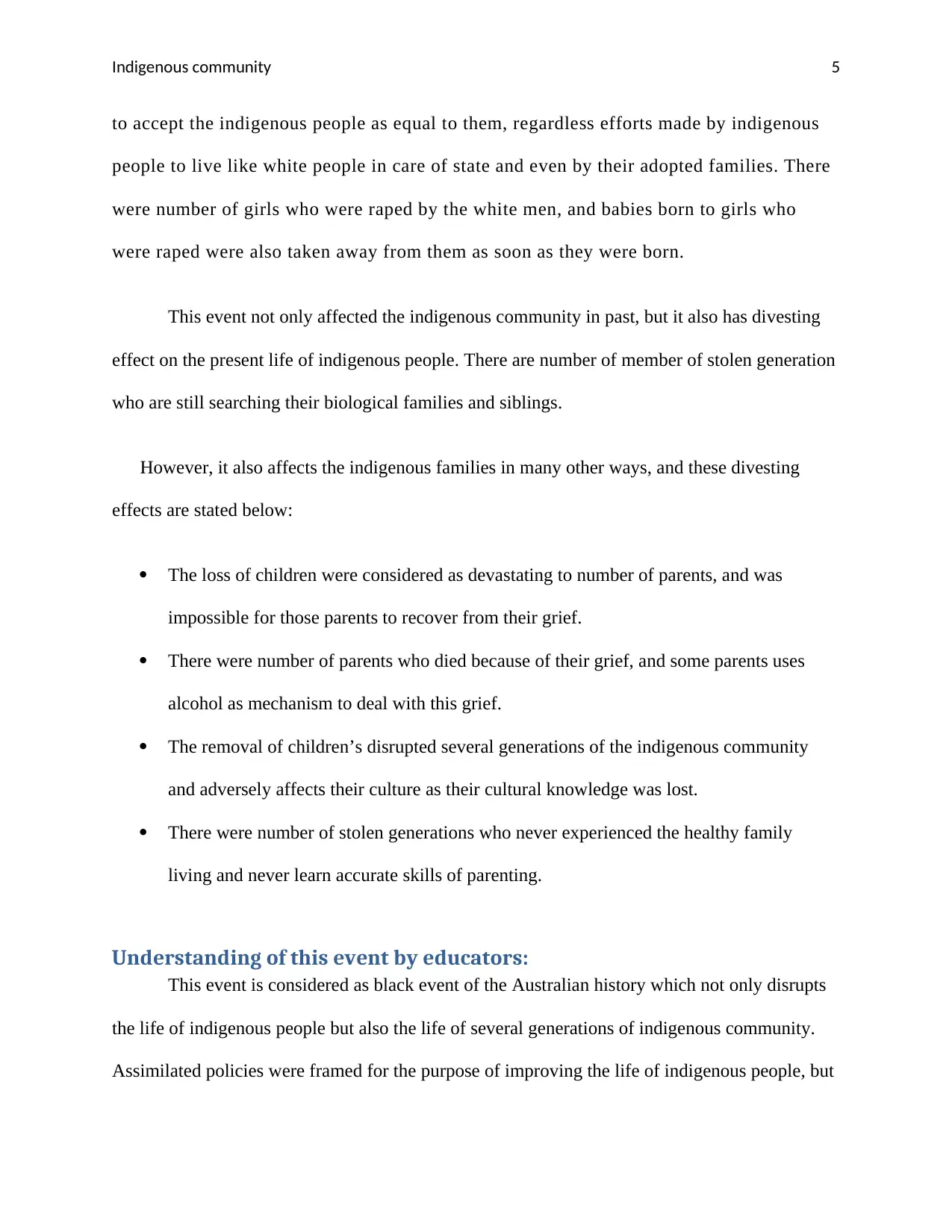
Indigenous community 5
to accept the indigenous people as equal to them, regardless efforts made by indigenous
people to live like white people in care of state and even by their adopted families. There
were number of girls who were raped by the white men, and babies born to girls who
were raped were also taken away from them as soon as they were born.
This event not only affected the indigenous community in past, but it also has divesting
effect on the present life of indigenous people. There are number of member of stolen generation
who are still searching their biological families and siblings.
However, it also affects the indigenous families in many other ways, and these divesting
effects are stated below:
The loss of children were considered as devastating to number of parents, and was
impossible for those parents to recover from their grief.
There were number of parents who died because of their grief, and some parents uses
alcohol as mechanism to deal with this grief.
The removal of children’s disrupted several generations of the indigenous community
and adversely affects their culture as their cultural knowledge was lost.
There were number of stolen generations who never experienced the healthy family
living and never learn accurate skills of parenting.
Understanding of this event by educators:
This event is considered as black event of the Australian history which not only disrupts
the life of indigenous people but also the life of several generations of indigenous community.
Assimilated policies were framed for the purpose of improving the life of indigenous people, but
to accept the indigenous people as equal to them, regardless efforts made by indigenous
people to live like white people in care of state and even by their adopted families. There
were number of girls who were raped by the white men, and babies born to girls who
were raped were also taken away from them as soon as they were born.
This event not only affected the indigenous community in past, but it also has divesting
effect on the present life of indigenous people. There are number of member of stolen generation
who are still searching their biological families and siblings.
However, it also affects the indigenous families in many other ways, and these divesting
effects are stated below:
The loss of children were considered as devastating to number of parents, and was
impossible for those parents to recover from their grief.
There were number of parents who died because of their grief, and some parents uses
alcohol as mechanism to deal with this grief.
The removal of children’s disrupted several generations of the indigenous community
and adversely affects their culture as their cultural knowledge was lost.
There were number of stolen generations who never experienced the healthy family
living and never learn accurate skills of parenting.
Understanding of this event by educators:
This event is considered as black event of the Australian history which not only disrupts
the life of indigenous people but also the life of several generations of indigenous community.
Assimilated policies were framed for the purpose of improving the life of indigenous people, but
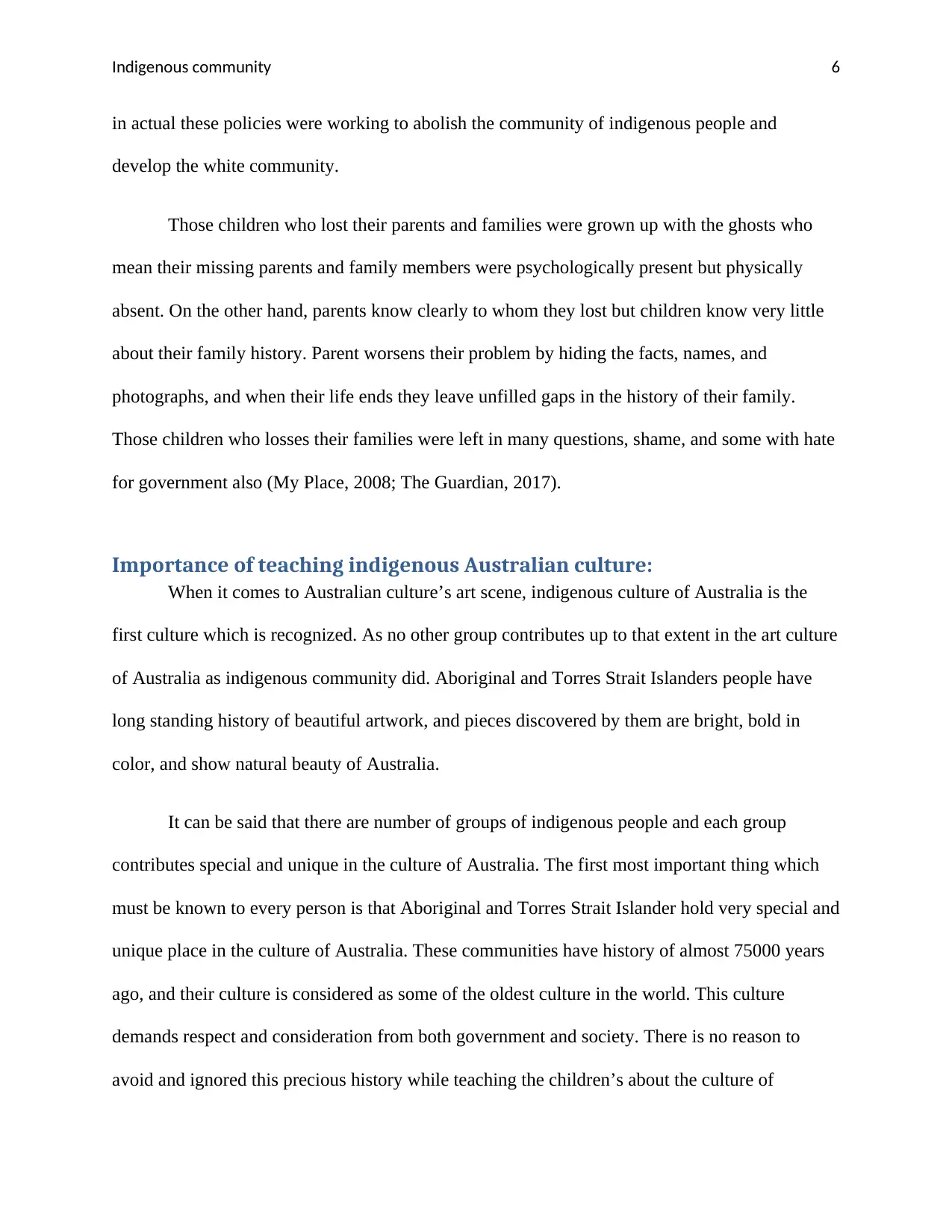
Indigenous community 6
in actual these policies were working to abolish the community of indigenous people and
develop the white community.
Those children who lost their parents and families were grown up with the ghosts who
mean their missing parents and family members were psychologically present but physically
absent. On the other hand, parents know clearly to whom they lost but children know very little
about their family history. Parent worsens their problem by hiding the facts, names, and
photographs, and when their life ends they leave unfilled gaps in the history of their family.
Those children who losses their families were left in many questions, shame, and some with hate
for government also (My Place, 2008; The Guardian, 2017).
Importance of teaching indigenous Australian culture:
When it comes to Australian culture’s art scene, indigenous culture of Australia is the
first culture which is recognized. As no other group contributes up to that extent in the art culture
of Australia as indigenous community did. Aboriginal and Torres Strait Islanders people have
long standing history of beautiful artwork, and pieces discovered by them are bright, bold in
color, and show natural beauty of Australia.
It can be said that there are number of groups of indigenous people and each group
contributes special and unique in the culture of Australia. The first most important thing which
must be known to every person is that Aboriginal and Torres Strait Islander hold very special and
unique place in the culture of Australia. These communities have history of almost 75000 years
ago, and their culture is considered as some of the oldest culture in the world. This culture
demands respect and consideration from both government and society. There is no reason to
avoid and ignored this precious history while teaching the children’s about the culture of
in actual these policies were working to abolish the community of indigenous people and
develop the white community.
Those children who lost their parents and families were grown up with the ghosts who
mean their missing parents and family members were psychologically present but physically
absent. On the other hand, parents know clearly to whom they lost but children know very little
about their family history. Parent worsens their problem by hiding the facts, names, and
photographs, and when their life ends they leave unfilled gaps in the history of their family.
Those children who losses their families were left in many questions, shame, and some with hate
for government also (My Place, 2008; The Guardian, 2017).
Importance of teaching indigenous Australian culture:
When it comes to Australian culture’s art scene, indigenous culture of Australia is the
first culture which is recognized. As no other group contributes up to that extent in the art culture
of Australia as indigenous community did. Aboriginal and Torres Strait Islanders people have
long standing history of beautiful artwork, and pieces discovered by them are bright, bold in
color, and show natural beauty of Australia.
It can be said that there are number of groups of indigenous people and each group
contributes special and unique in the culture of Australia. The first most important thing which
must be known to every person is that Aboriginal and Torres Strait Islander hold very special and
unique place in the culture of Australia. These communities have history of almost 75000 years
ago, and their culture is considered as some of the oldest culture in the world. This culture
demands respect and consideration from both government and society. There is no reason to
avoid and ignored this precious history while teaching the children’s about the culture of
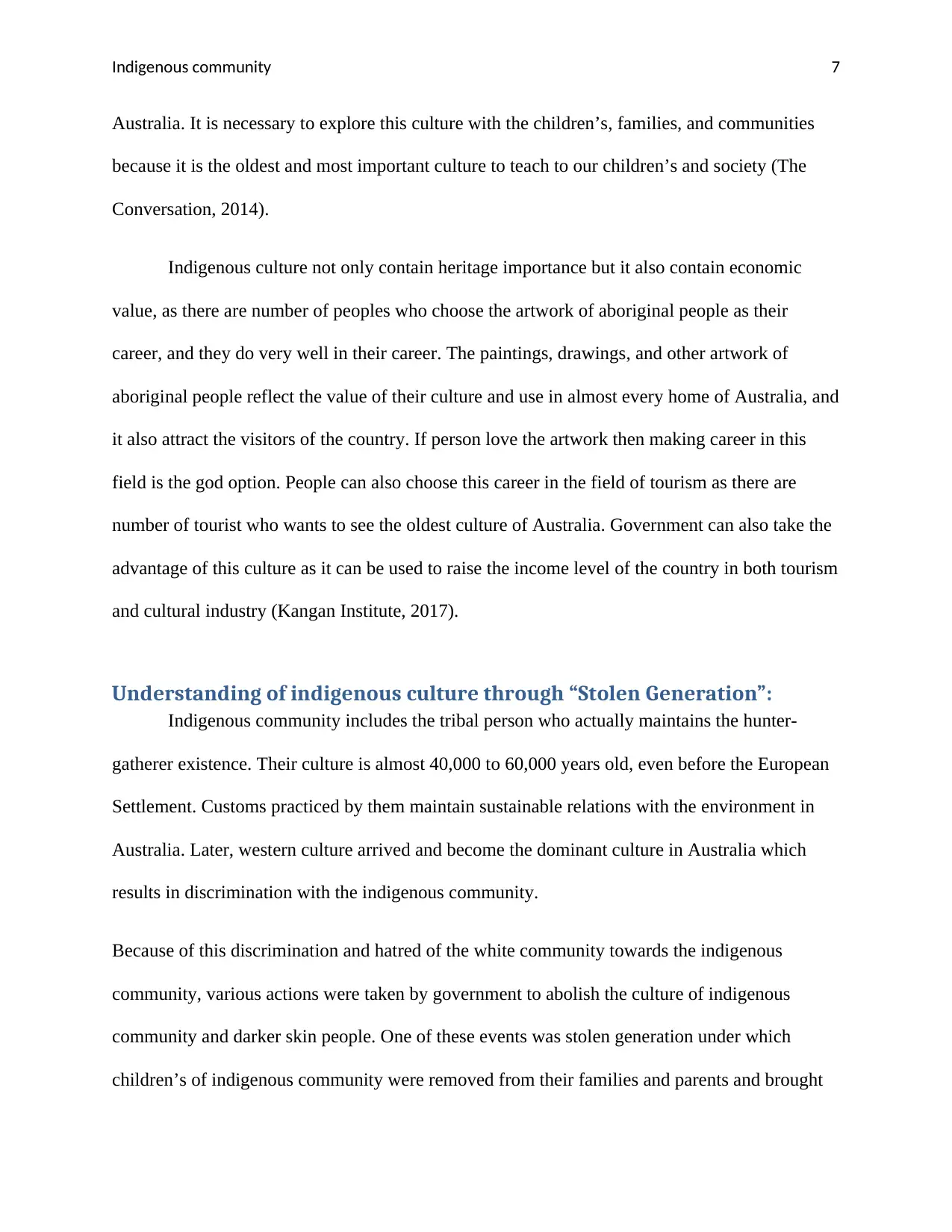
Indigenous community 7
Australia. It is necessary to explore this culture with the children’s, families, and communities
because it is the oldest and most important culture to teach to our children’s and society (The
Conversation, 2014).
Indigenous culture not only contain heritage importance but it also contain economic
value, as there are number of peoples who choose the artwork of aboriginal people as their
career, and they do very well in their career. The paintings, drawings, and other artwork of
aboriginal people reflect the value of their culture and use in almost every home of Australia, and
it also attract the visitors of the country. If person love the artwork then making career in this
field is the god option. People can also choose this career in the field of tourism as there are
number of tourist who wants to see the oldest culture of Australia. Government can also take the
advantage of this culture as it can be used to raise the income level of the country in both tourism
and cultural industry (Kangan Institute, 2017).
Understanding of indigenous culture through “Stolen Generation”:
Indigenous community includes the tribal person who actually maintains the hunter-
gatherer existence. Their culture is almost 40,000 to 60,000 years old, even before the European
Settlement. Customs practiced by them maintain sustainable relations with the environment in
Australia. Later, western culture arrived and become the dominant culture in Australia which
results in discrimination with the indigenous community.
Because of this discrimination and hatred of the white community towards the indigenous
community, various actions were taken by government to abolish the culture of indigenous
community and darker skin people. One of these events was stolen generation under which
children’s of indigenous community were removed from their families and parents and brought
Australia. It is necessary to explore this culture with the children’s, families, and communities
because it is the oldest and most important culture to teach to our children’s and society (The
Conversation, 2014).
Indigenous culture not only contain heritage importance but it also contain economic
value, as there are number of peoples who choose the artwork of aboriginal people as their
career, and they do very well in their career. The paintings, drawings, and other artwork of
aboriginal people reflect the value of their culture and use in almost every home of Australia, and
it also attract the visitors of the country. If person love the artwork then making career in this
field is the god option. People can also choose this career in the field of tourism as there are
number of tourist who wants to see the oldest culture of Australia. Government can also take the
advantage of this culture as it can be used to raise the income level of the country in both tourism
and cultural industry (Kangan Institute, 2017).
Understanding of indigenous culture through “Stolen Generation”:
Indigenous community includes the tribal person who actually maintains the hunter-
gatherer existence. Their culture is almost 40,000 to 60,000 years old, even before the European
Settlement. Customs practiced by them maintain sustainable relations with the environment in
Australia. Later, western culture arrived and become the dominant culture in Australia which
results in discrimination with the indigenous community.
Because of this discrimination and hatred of the white community towards the indigenous
community, various actions were taken by government to abolish the culture of indigenous
community and darker skin people. One of these events was stolen generation under which
children’s of indigenous community were removed from their families and parents and brought
Paraphrase This Document
Need a fresh take? Get an instant paraphrase of this document with our AI Paraphraser
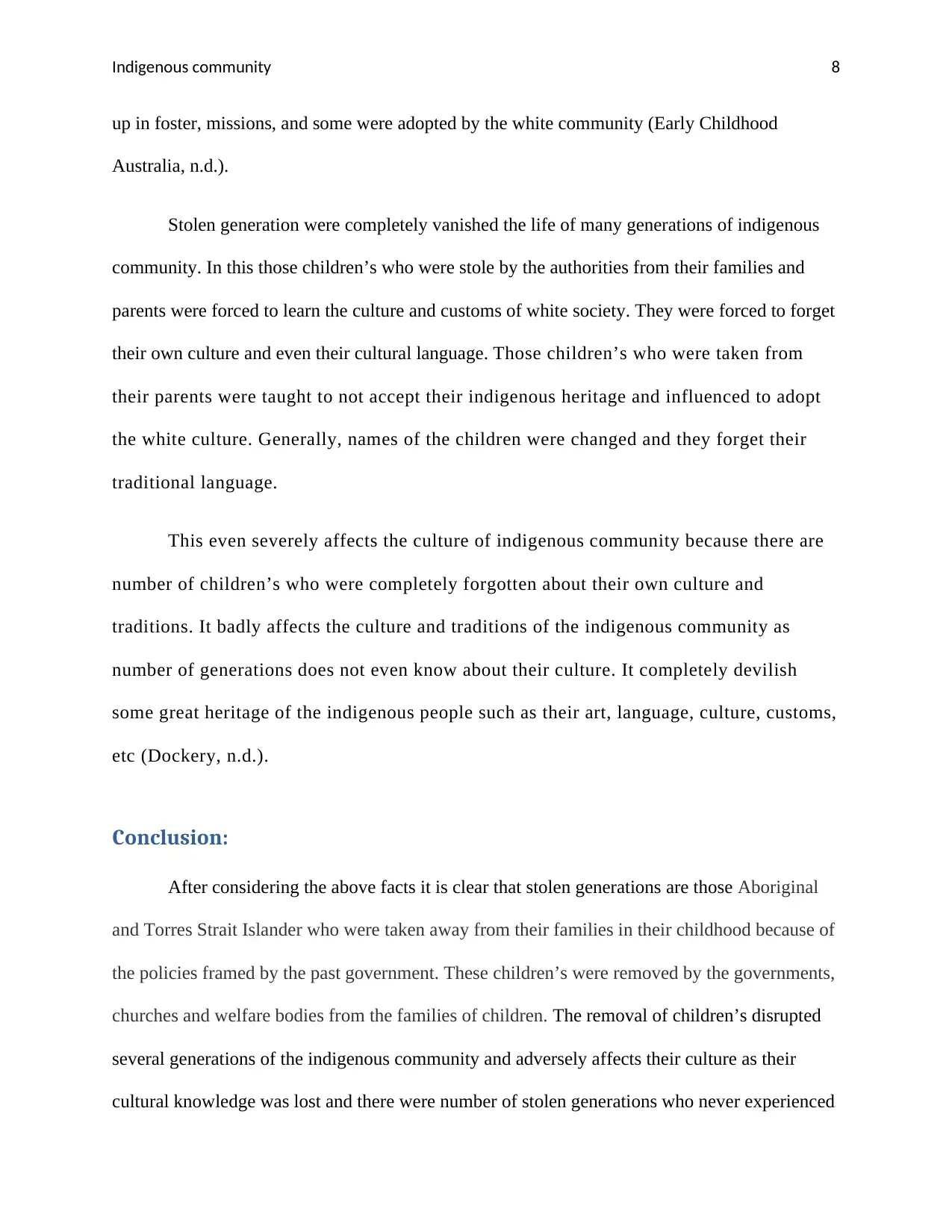
Indigenous community 8
up in foster, missions, and some were adopted by the white community (Early Childhood
Australia, n.d.).
Stolen generation were completely vanished the life of many generations of indigenous
community. In this those children’s who were stole by the authorities from their families and
parents were forced to learn the culture and customs of white society. They were forced to forget
their own culture and even their cultural language. Those children’s who were taken from
their parents were taught to not accept their indigenous heritage and influenced to adopt
the white culture. Generally, names of the children were changed and they forget their
traditional language.
This even severely affects the culture of indigenous community because there are
number of children’s who were completely forgotten about their own culture and
traditions. It badly affects the culture and traditions of the indigenous community as
number of generations does not even know about their culture. It completely devilish
some great heritage of the indigenous people such as their art, language, culture, customs,
etc (Dockery, n.d.).
Conclusion:
After considering the above facts it is clear that stolen generations are those Aboriginal
and Torres Strait Islander who were taken away from their families in their childhood because of
the policies framed by the past government. These children’s were removed by the governments,
churches and welfare bodies from the families of children. The removal of children’s disrupted
several generations of the indigenous community and adversely affects their culture as their
cultural knowledge was lost and there were number of stolen generations who never experienced
up in foster, missions, and some were adopted by the white community (Early Childhood
Australia, n.d.).
Stolen generation were completely vanished the life of many generations of indigenous
community. In this those children’s who were stole by the authorities from their families and
parents were forced to learn the culture and customs of white society. They were forced to forget
their own culture and even their cultural language. Those children’s who were taken from
their parents were taught to not accept their indigenous heritage and influenced to adopt
the white culture. Generally, names of the children were changed and they forget their
traditional language.
This even severely affects the culture of indigenous community because there are
number of children’s who were completely forgotten about their own culture and
traditions. It badly affects the culture and traditions of the indigenous community as
number of generations does not even know about their culture. It completely devilish
some great heritage of the indigenous people such as their art, language, culture, customs,
etc (Dockery, n.d.).
Conclusion:
After considering the above facts it is clear that stolen generations are those Aboriginal
and Torres Strait Islander who were taken away from their families in their childhood because of
the policies framed by the past government. These children’s were removed by the governments,
churches and welfare bodies from the families of children. The removal of children’s disrupted
several generations of the indigenous community and adversely affects their culture as their
cultural knowledge was lost and there were number of stolen generations who never experienced
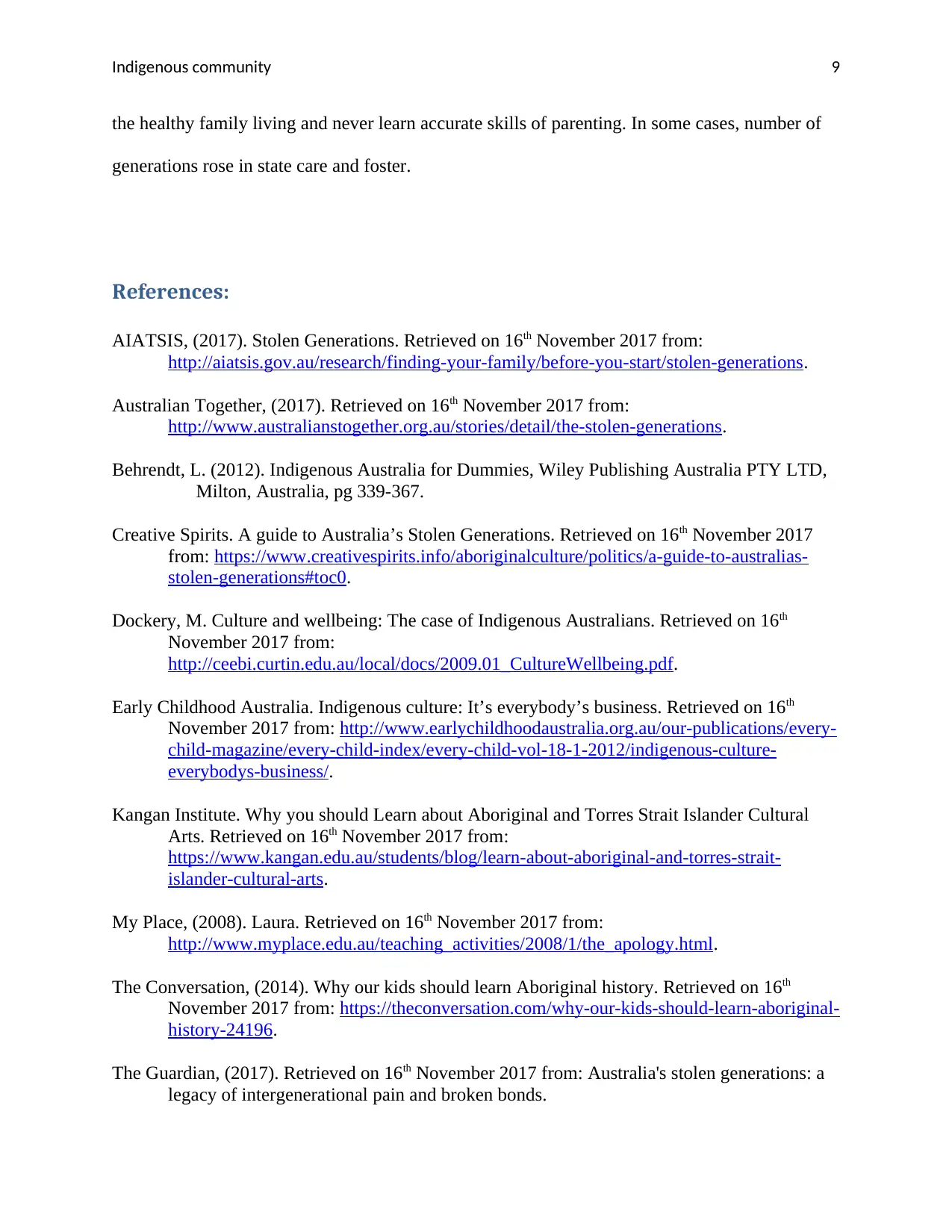
Indigenous community 9
the healthy family living and never learn accurate skills of parenting. In some cases, number of
generations rose in state care and foster.
References:
AIATSIS, (2017). Stolen Generations. Retrieved on 16th November 2017 from:
http://aiatsis.gov.au/research/finding-your-family/before-you-start/stolen-generations.
Australian Together, (2017). Retrieved on 16th November 2017 from:
http://www.australianstogether.org.au/stories/detail/the-stolen-generations.
Behrendt, L. (2012). Indigenous Australia for Dummies, Wiley Publishing Australia PTY LTD,
Milton, Australia, pg 339-367.
Creative Spirits. A guide to Australia’s Stolen Generations. Retrieved on 16th November 2017
from: https://www.creativespirits.info/aboriginalculture/politics/a-guide-to-australias-
stolen-generations#toc0.
Dockery, M. Culture and wellbeing: The case of Indigenous Australians. Retrieved on 16th
November 2017 from:
http://ceebi.curtin.edu.au/local/docs/2009.01_CultureWellbeing.pdf.
Early Childhood Australia. Indigenous culture: It’s everybody’s business. Retrieved on 16th
November 2017 from: http://www.earlychildhoodaustralia.org.au/our-publications/every-
child-magazine/every-child-index/every-child-vol-18-1-2012/indigenous-culture-
everybodys-business/.
Kangan Institute. Why you should Learn about Aboriginal and Torres Strait Islander Cultural
Arts. Retrieved on 16th November 2017 from:
https://www.kangan.edu.au/students/blog/learn-about-aboriginal-and-torres-strait-
islander-cultural-arts.
My Place, (2008). Laura. Retrieved on 16th November 2017 from:
http://www.myplace.edu.au/teaching_activities/2008/1/the_apology.html.
The Conversation, (2014). Why our kids should learn Aboriginal history. Retrieved on 16th
November 2017 from: https://theconversation.com/why-our-kids-should-learn-aboriginal-
history-24196.
The Guardian, (2017). Retrieved on 16th November 2017 from: Australia's stolen generations: a
legacy of intergenerational pain and broken bonds.
the healthy family living and never learn accurate skills of parenting. In some cases, number of
generations rose in state care and foster.
References:
AIATSIS, (2017). Stolen Generations. Retrieved on 16th November 2017 from:
http://aiatsis.gov.au/research/finding-your-family/before-you-start/stolen-generations.
Australian Together, (2017). Retrieved on 16th November 2017 from:
http://www.australianstogether.org.au/stories/detail/the-stolen-generations.
Behrendt, L. (2012). Indigenous Australia for Dummies, Wiley Publishing Australia PTY LTD,
Milton, Australia, pg 339-367.
Creative Spirits. A guide to Australia’s Stolen Generations. Retrieved on 16th November 2017
from: https://www.creativespirits.info/aboriginalculture/politics/a-guide-to-australias-
stolen-generations#toc0.
Dockery, M. Culture and wellbeing: The case of Indigenous Australians. Retrieved on 16th
November 2017 from:
http://ceebi.curtin.edu.au/local/docs/2009.01_CultureWellbeing.pdf.
Early Childhood Australia. Indigenous culture: It’s everybody’s business. Retrieved on 16th
November 2017 from: http://www.earlychildhoodaustralia.org.au/our-publications/every-
child-magazine/every-child-index/every-child-vol-18-1-2012/indigenous-culture-
everybodys-business/.
Kangan Institute. Why you should Learn about Aboriginal and Torres Strait Islander Cultural
Arts. Retrieved on 16th November 2017 from:
https://www.kangan.edu.au/students/blog/learn-about-aboriginal-and-torres-strait-
islander-cultural-arts.
My Place, (2008). Laura. Retrieved on 16th November 2017 from:
http://www.myplace.edu.au/teaching_activities/2008/1/the_apology.html.
The Conversation, (2014). Why our kids should learn Aboriginal history. Retrieved on 16th
November 2017 from: https://theconversation.com/why-our-kids-should-learn-aboriginal-
history-24196.
The Guardian, (2017). Retrieved on 16th November 2017 from: Australia's stolen generations: a
legacy of intergenerational pain and broken bonds.
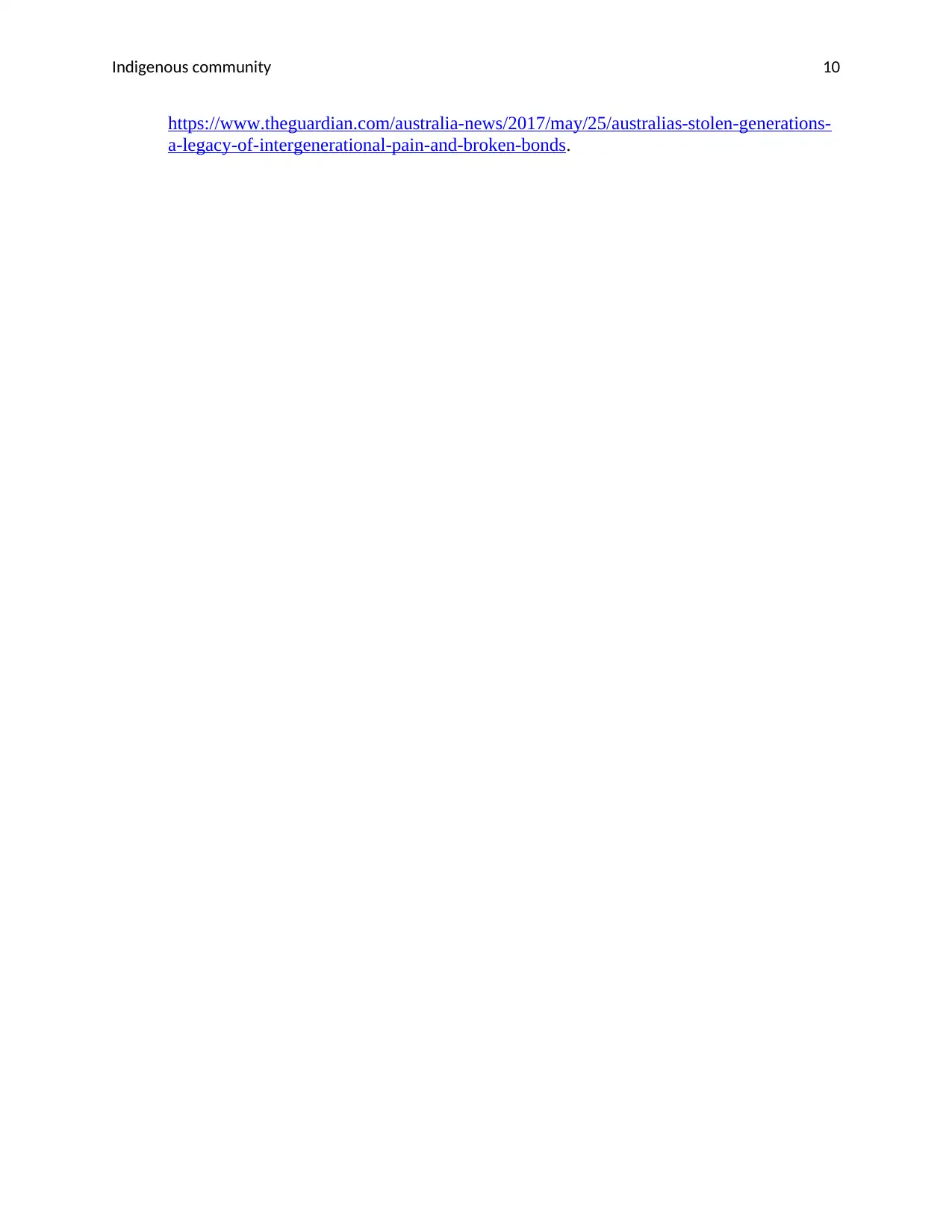
Indigenous community 10
https://www.theguardian.com/australia-news/2017/may/25/australias-stolen-generations-
a-legacy-of-intergenerational-pain-and-broken-bonds.
https://www.theguardian.com/australia-news/2017/may/25/australias-stolen-generations-
a-legacy-of-intergenerational-pain-and-broken-bonds.
1 out of 10
Related Documents
Your All-in-One AI-Powered Toolkit for Academic Success.
+13062052269
info@desklib.com
Available 24*7 on WhatsApp / Email
![[object Object]](/_next/static/media/star-bottom.7253800d.svg)
Unlock your academic potential
© 2024 | Zucol Services PVT LTD | All rights reserved.





